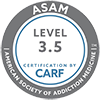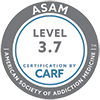Clinical Opiate Withdrawal Scale (COWS)
The Clinical Opiate Withdrawal Scale or COWS is just that. It is a scale that a clinician uses to measure opiate withdrawal symptoms. A trained clinician will use this scale in an inpatient setting or as part of outpatient treatment. The scale is used most often to measure the extent of withdrawal symptoms in a person who is addicted to opioids, but it is also used in a healthcare setting in which the patient has been given opiates for the treatment of pain.
The scale allows the clinician to determine the severity of the signs and symptoms of opioid withdrawal so that these symptoms can be monitored over time. In this way, the clinician can determine which stage the patient is in and how severe the addiction is at the given moment.
Assessments 1 – 3 in the Clinical Opiate Withdrawal Scale
The first assessment is for the “Resting Pulse Rate.”
The clinician will take this measurement after the patient has been sitting or lying down for a total of 1 minute. Just prior to the test, the patient must not have been engaged in any vigorous activity. If the patient is rated at “0,” his or her heart rate is at or below 80 beats per minute. A score of “4” means that the patient’s heart rate is more than 120 beats per minute.
The second assessment is for “Sweating.”
Patient activity and the temperature of the room must not account for the reason that the patient is sweaty. This assessment will measure the patient over a period of 30 minutes. “0” means that there is no sweating present, and “1” means that the patient is experiencing chills or flushing. An assessment of “4” means that sweat is pouring down the patient’s face.
The third assessment is for “Restlessness.”
A “0” means that the patient can sit still without any difficulty. A “1” means that this is a little difficult to do, but the patient can remain seated. A “3” means that the patient feels the need to move around a lot, and “4” means that the patient is unable to sit still for more than 2 seconds.
Continued after image:
Assessments 4 – 6 in the Clinical Opiate Withdrawal Scale
The fourth assessment is for “Pupil Size.”
A patient whose pupils are of average size in a normally lit room receives a score of “0.” On the other hand, someone who has pupils so large that only a thin rim of the iris is visible is given a “5.”
The fifth assessment is for “Bone or Joint Aches.”
The patient had pain before opiates were ingested, but this pain is not assessed here. If there is no pain, the clinician gives a score of “0” while extreme pain is given the score of “4.”
The sixth assessment is for “Runny Nose or Tearing.”
The runny nose or tearing must be attributed to the withdrawal symptoms and not a cold or allergy. If these symptoms aren’t present, the patient receives a score of “0.” Tears that are streaming down the patient’s face and a constantly running nose are given a score of “4.”
Assessments 7 – 9 in the Clinical Opiate Withdrawal Scale
The seventh assessment is for “GI Upset.”
Only the previous half hour before the assessment was taken will be considered. No GI symptoms will warrant a score of “0,” and several episodes of diarrhea or vomiting will require a score of “4.”
The eighth assessment is for “Tremor.”
The clinician observes the patient’s outstretched hands and gives a rating of “0” for the absence of tremors. Excessive muscle twitching or extreme tremors will be rated with a “4.”
The ninth assessment is for “Yawning.”
The clinician will observe the patient during the entire assessment to reach a conclusion. A score of “0” will mean that the patient did not yawn once, and a score of “4” will mean that the patient yawned numerous times every minute.
Assessments 10 – 11 in the Clinical Opiate Withdrawal Scale
The tenth assessment is for “Anxiety or Irritability.”
If no signs of anxiety or irritability are present, the patient receives a “0.” If the patient is visibly irritable or anxious, he or she receives a score of “4.”
The eleventh assessment is for “Gooseflesh skin.”
Smooth skin receives a “0.” If hair can be seen to be standing up erect, it is given a “3.” When the hairs are prominently displayed on the legs or arms, the patient receives a “5.”
Once the Clinical Assessment is Complete
After the assessment is complete, the clinician adds up the scores of the Clinical Opiate Withdrawal Scale so that he or she can see numerically how much the patient is suffering from opioid withdrawal. The patient is experiencing mild withdrawal symptoms if his or her score is ranked from 5 to 12. A patient whose score is 36 or higher has a severe case of withdrawal. The patient’s score as well as his or her history help the clinician develop an ongoing treatment plan for the coming days.








